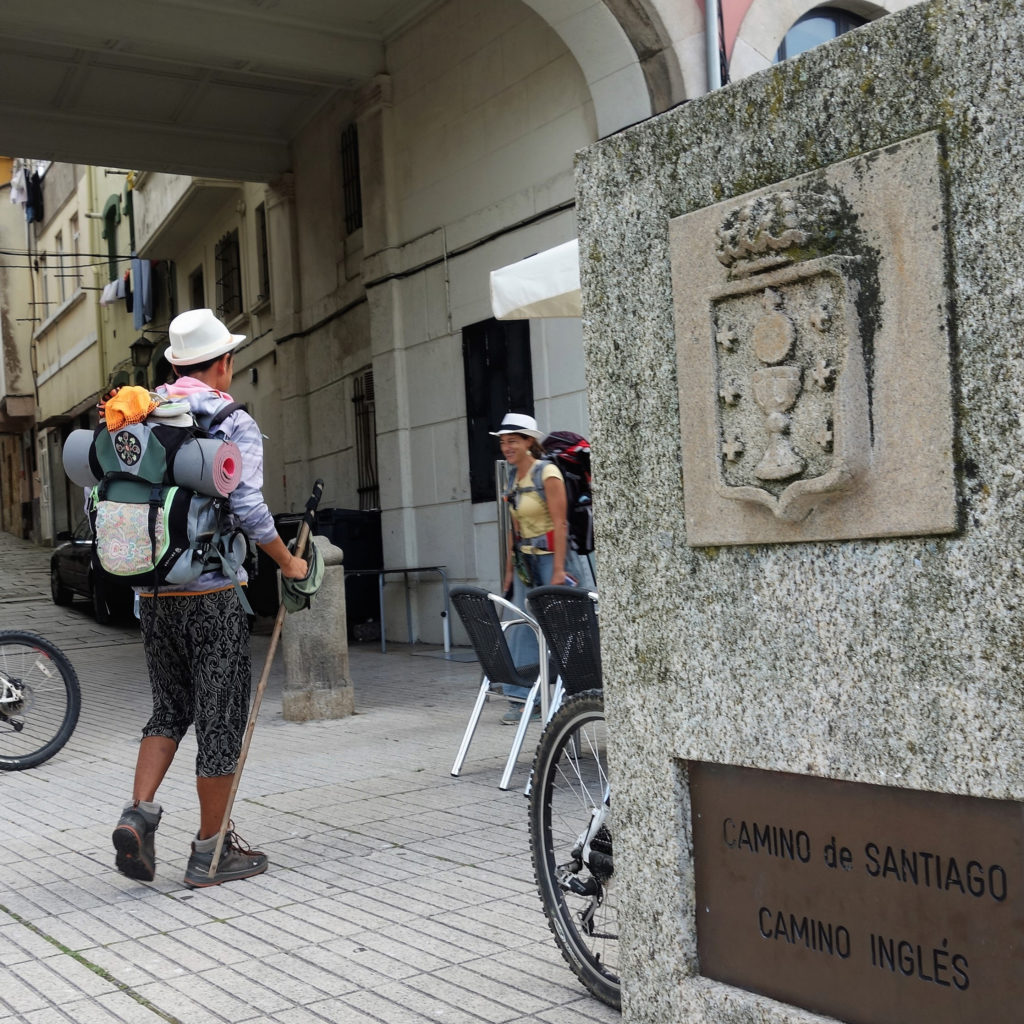
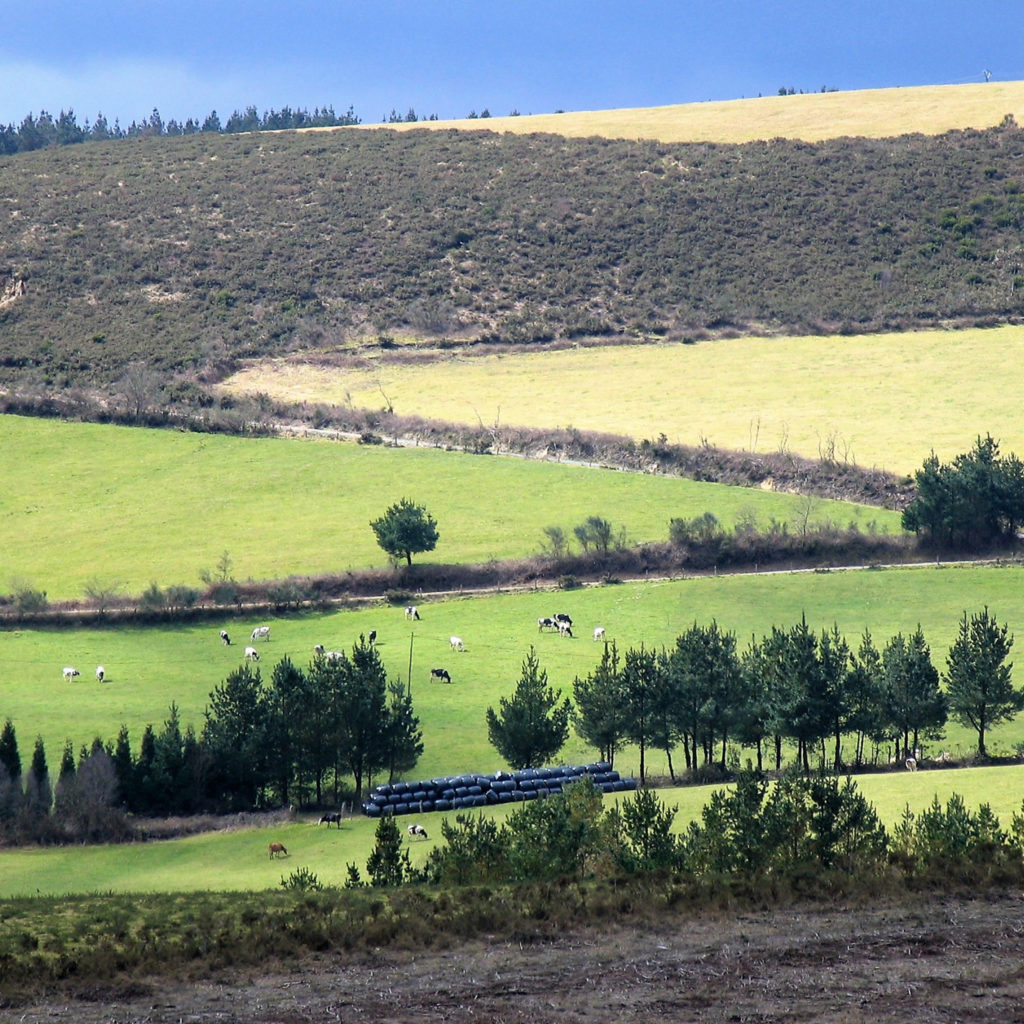
during the way
Step by step, soft then softly
We come up against each other, little by little
(Luis Fonsi)
As in Luis Fonsi’s song, you and the Way will gradually become one, and the route itself will teach you lessons so that you end up being part of it. Then you will inevitably be a pilgrim.
THE STAGES OF THE PILGRIM
It is usually the case that the pilgrim becomes physically and mentally stronger as he advances. What at first seems frightening—long distances or mountains—in time become perfectly acceptable challenges. As is commonly said, the worst days are the first, but not so much the very beginning, where we are normally in a state of euphoria, as the second or third days. This is when the first blisters and muscular pains appear. It is good to manage the adventure at this point so as not to end up in a state of collapse: willpower and self-esteem can be great allies, but also irresponsible advisers. As Machado said, when you look back, you will see not only footprints that you will never step on again in the same way, but also how much you have learned in a short time.
MARKING
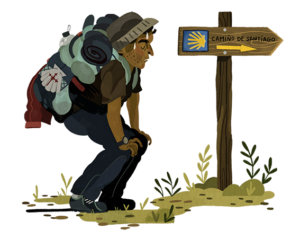
Overall, the Way of Saint James is well marked, particularly as you get closer to the goal, and especially in Galicia. There are yellow arrows, which the Amigos del Camino association replaces on a regular basis. They coexist with stones or cement boundary stones, ceramic plaques, wooden or metal signposts, shells and plaques on the ground, crosses of Santiago, logos of the Council of Europe and many other elements according to the sponsor.
ROAD SURFACE
Although the surface varies greatly depending on the roads and sections, you should be prepared that agricultural or forest trails, paths and tracks may account for 50 per cent, and paved roads, mostly local but also some roads with more traffic, for the remaining 50 per cent.
THE CREDENCIAL AND ITS USE
The credencial is the document most appreciated by pilgrims. It is the password that identifies pilgrims as such, allowing them to access certain hostels and obtain the Compostela. The credencial has replaced the old safe conduct and letters of introduction. It was created by the Amigos del Camino association in the 1980s, unified in 1987, and recognised by the Cathedral of Santiago, which later created its own.
After a failed attempt by the Cathedral of Santiago to monopolise the printing of the document, both the Cathedral’s credencial and the federated associations’ credentials coexist. Some itineraries also have their own credential, and the same goes for foreign associations, all of which are valid for accommodation in pilgrim hostels. In addition, if they have been previously approved by the Cathedral of Compostela, they can also obtain the Compostela certificate.
The credential has room for personal data, which should match your ID or password data, and for transit stamps, with enough space to put add a day except for the last 100 km, where two are required daily to receive the Compostela if travelling on foot.
The credencialcan be obtained through the Amigos del Camino associations. Some of these associations will only serve the document in person. It can also be obtained at the main starting points of the different routes, from church premises and from associations or public entities. Today, it is made as easy as possible so that no one is without their credential.
PILGRIM’S BLESSING
The pilgrim’s blessing is a tradition that has been reinstated in some of the commonplaces of departure (you will find information in the guide). It is an exciting act that follows certain practices from the Middle Ages, whether you are a believer or not. It often takes place at the end of a mass.
FOOD
Your diet is essential to compensate for the intense expenditure of energy. Everyone is aware of their needs, but it is good to remember that on the Camino people tend to eat differently, both in terms of timetables and the types of food, which some find it hard to adapt to.
First of all, breakfast is an important time of day, as we need an energy intake to avoid cramps and fainting. It should ideally be composed of dairy products, cereal or toast (with oil and/or tomato, for example) and glucose, present in juices and fruit, also in jams, honey, chocolate, etc.
During the walk, it is good to eat more fresh fruit, nuts, cookies, energy bars or similar. Every two hours, it is a good idea to eat something, along with water or drinks with mineral salts added for sport.
On the Camino, midday is exactly midday. In other words, when the sun reaches its highest point, it is not advisable to eat a lot, and even less so the main meal of the day, because digestion will be sluggish and we will no longer feel like continuing. A light dish (salad, pasta), some tapas (potato omelette is a classic in Spain) or a sandwich that we can buy in a shop or supermarket or, better still, make ourselves, will suffice.
After arriving at the accommodation, a light snack, tapas or picnic every two hours can be perfect, accompanied by a hot drink or a beer.
As far as dinner is concerned, it is advisable to eat it before the usual Spanish and Portuguese opening hours. You will be able to cook something substantial at the hostel (the best idea is to reach an agreement among several pilgrims), to sign up for the communal dinner or go to an inn or restaurant. Dishes or menus of the day are often indicated for pilgrims, which include two dishes, dessert, drink and sometimes also coffee for a fixed price. The pilgrim’s menu, daily menu or diárias costs 9–14 euros on average in Spain and 6–8 euros in Portugal; however, in Portugal it is not always of good quality. Find out in advance if there are varied, balanced menus and, if possible, home-cooked and made with local products. This would be the maximum, and we can help you find it.
It is also common that in rural hostels without shops or services nearby, restaurant will make food to order, and even transport the pilgrims who want to go to eat.
As for shopping, don’t forget to plan it, taking into account the services of each stage and opening hours (beware of holidays). We don’t recommend that you overload your backpack. It is better if you buy what you are going to eat every day, always trying to have a reserve of fruits and cereals, some energy (nuts, chocolate, biscuits), and maybe one or two cans just in case. Carrying large amounts of water when there are fountains, shops and bars on most roads is inadvisable and unnecessary.
If you cook in a hostel you may find some basic ingredients such as salt, sugar, spices, oil, vinegar, flour, etc., and what other pilgrims have left, especially pasta, rice and vegetables, so as not to have to carry it. If you use it, think of those who will come after you tomorrow, and try to replace it or do the same on another occasion.
ACCOMMODATION
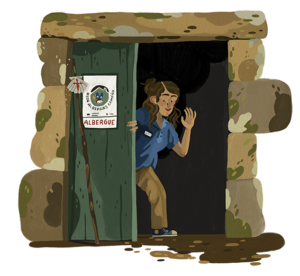
There are many options for spending the night on the Camino, but many pilgrims, regardless of their spending capacity, choose hostels because they are more fully experienced. Hostels can be of many types, from the most modest to those offering hotel services (private rooms, sauna, swimming pool, etc.), and prices are usually in line with the services offered.
On roads that are not yet so popular, or among the roads passing through communities becoming involved in their promotion (especially in Galicia), public hostels abound. In many cases, they are subsidised and have low prices, or even accept donations and are managed by associations and/or volunteer hospitaleros. There are also some parish hostels or hostels transferred to Jacobean associations for their management. They usually offer a warm welcome, since those who work at them have usually been pilgrims, and they know our needs better than anyone else. One of the most enjoyable moments of the stay is the community dinner organised by some hostels, sometimes involving those present in the preparation, service and cleaning.
Whether you book the hostel in advance or you choose from several options when you arrive in the village, it is advisable to read the reviews left by other pilgrims on the internet (although they do not always correspond to reality due to interference from interested parties). Above all, you should examine the services offered, the number of beds per dormitory, gender-based limitations, the number of private rooms, lockers with keys, a kitchen with cooking utensils, washing machine and dryer, pet conditions, etc. If you are in the city and want to take a walk in the evening, you should also know in advance the closing time, or if it has an access system with a key, electronic card or code. Finally, among those who do not like to carry a lot of money with them, it is useful to know if hostels accept payment by bank card.
As a rule, public hostels in Spain and Portugal do not accept reservations, so pilgrims are welcomed on a first-come, first-served basis. This has led to queues forming early in the holiday season, one of the biggest absurdities on the Way. This could be partly solved by freeing up some of the places for long-distance pilgrims or for those who have walked a minimum amount per day. However, those in charge are usually more interested in quantity than quality to boast results.
You can make reservations in private hostels, though, which are slightly more expensive (10–15 euros on average, with higher prices in urban hostels). Sometimes you will have to provide a card number to confirm the reservation. It will be kept until a certain hour, so if you are late you will have to call again.
In order to make coexistence possible in hostels, it is necessary to respect the rules, especially those referring to the use of facilities such as the kitchen and silence after a certain time. Likewise, we must leave everything as we found it, doing the dishes and trying not to be dirty any more than necessary. It is worth remembering that a hostel is not a hotel.
The use of other types of accommodation—be they guest houses or hostels (local and residential accommodation in Portugal), rural or agrotourism houses and hotels (also habitação tourism in Portugal), inns, hotels or, in recent years, tourist apartments and flats, interesting for families or small groups—is regulated by the different tourist regulations in each autonomous community (Spain), and prices vary according to supply and demand, although there are more and more pilgrim-oriented business with special prices for us.
WITHDRAWING MONEY
First of all, you should ascertain the existence of banks and ATMs so that you can withdraw money on the Camino. You should not bring a lot of money with you: it could be stolen. You should also verify the conditions of your card to operate abroad. You may be able to withdraw a certain number of times for free or certain amounts depending on your card. The norm is for banks to charge 3 per cent commission and/or currency exchange fees, which are usually unfavourable.
Changing money at airports upon arrival is not a good idea because of the exchange rate, which is better at exchange offices in city centres.
In Spain, we are familiar with the practices of ATMs, the existence of three networks (4B, ServiRed and Euro 6000) and abusive banking practices by applying fees for not using the ATMs in their branches or the network to which they belong. In Portugal, it is more convenient, as all ATMs belong to the Multibanco network, and all the services are integrated and without fees. The same applies in France.
To avoid theft, pilgrims prefer to pay with cards, but this is not possible everywhere. A good solution on the go is rechargeable prepaid cards, such as that offered by Mastercard for €6.
MOST COMMON INCIDENTS
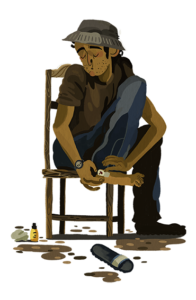
As feet are the primary sufferers, and we urbanites are no longer used to walking long distances, blisters will be one of the first punishments. Approximately 50 per cent of pilgrims have had them at some time, and although the type of footwear and socks used may influence this, the cause is usually genetic, related to sweat and skin type. It is necessary to avoid rubbing and perspiration buildup as much as possible. For that, it is necessary to dry the feet well and avoid wetting them in summer in basins and rivers to cool then. If things get very bad, you can resort to trekking sandals on smooth stretches. Smearing the feet with Vaseline in the morning can help, along with soothing your feet in cold salty water, or massaging them with rosemary alcohol. Once the blisters have appeared, there are a number of possible solutions for drying them, from the dressings sold in pharmacies, which do not suit everyone, to pricking them with a sterilised needle and thread, leaving the latter inside to drain. Once dry, a disinfectant should be applied, without breaking the skin.
The second most common problem concerns the weight that we carry on our backs, which is sometimes a lot. The rule is not to exceed 10 per cent of your bodyweight in the load, although this do not take into account a person’s physical condition, which is what matters. Weight and back pain can lead to poor posture, and this can lead to tendonitis or muscle inflammation. If you already suffer the condition, the doctor will as a rule tell you to stop for at least two or three days to relax the muscle. He or she may also prescribe a pain reliever or an elastic bandage for mild cases. If it does not get better, don’t try to push on: itis best to leave the Camino and come back another time.
A third element of danger is the sun, a source of life but also of various present and future problems due to many hours’ exposure to its radiation. Avoiding the central hours of the day, wearing adequate sun protection and protecting your head with a hat are mandatory to avoid sunstroke and burns. You could also use a scarf to protect your neck, all, of course, depending on one’s skin type. Cocoa bars can be used to protect the lips from the sun, as well as for dryness caused by the cold.
Associated with this can be dehydration, because you do not always drink what is necessary. On hot days, we have to drink three or four litres, preferably water that is neither too cold nor too hot. If we are dehydrated, we will notice it in our urine, which will be thick, dark and have an intense smell. Dizziness, and even fainting, can be a consequence of dehydration, and it is easy to prevent it. In certain stages with few toilets and fountains, it is advisable to be very careful and carry enough water.
Other common problems can be sprains or strains, which can be treated with cold cloths or elastic bandages. If these problems are not solved, go to the medical centre. Colds due to variations in temperature and wetness must be tackled. Other problems are related to physical exhaustion, sometimes associated with fever, and almost always associated with an excess or lack of sugar, which can lead to dizziness and tachycardia. Finally, there are the problems associated with food and intolerance and allergies, which are becoming more and more frequent.
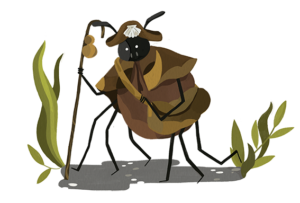
Insects on the Camino are the modern ordeal for the pilgrims. Bedbugs, against which there is an annual crusade on all the roads, have become famous. We always recommend checking the mattress and the bed base where you are going to sleep, as this is their preferred hiding place. You should also keep your eyes open in accommodation that does not appear very clean or is installed in an old building with a lot of wood. Once they have attacked us, the bites of bedbugs can be distinguished from those of mosquitoes or mites because they are multiple and follow regular lines. Don’t be embarrassed by these and try to hide them: it can happen to anyone. Talk first to those responsible for the accommodation, taking measures such as washing your clothes at 60º or adding a cap of scented ammonia and disinfecting your backpack. In many hostels, you will not be able to bring your backpack into the dormitories—only the sleeping bag, clothes to move around in and toiletries are allowed. Some people also carry a specific spray for bugs in their backpacks. Bedbugs also like to make pilgrimages—not on foot, but in our backpacks.
We have already mentioned mites, which are difficult to detect. Most hostels have mattresses that repel them. However, we should mention their danger, and the presence of ticks in rural areas with animals and forests. This arachnid waits for a chance to hook onto our skin (watch out for shorts and the head and neck in risk areas). Their bites are anaesthetising, so often we will not even realise we have been bitten. It is sensible to check when we arrive at our accommodation, since ticks need to be in contact with the body for at least 24 hours to infect us. The danger of a tick is that it is a transmitter of the bacteria that cause Lyme disease, which can lead to serious health problems. In pharmacies, we can buy special tweezers to remove the ticks in case we are bitten, turning the insect like a screw counter-clockwise, pulling upwards and applying then a disinfectant. You can also use the tweezers for hair. If the tick’s hooks remain stuck under the skin, it can cause an infection, which will manifest itself sometime later in the appearance of a large red aureole. Dogs without anti-parasite collars can be tick carriers, and the same goes for other animals.
Some traffic accidents take place either at black spots on the Way, indicated in the guides (do not take it as a joke), and because of the absurd custom of walking before the dawn to get a bed before anyone and avoid the hottest hours, encouraged by irresponsible opinion leaders. It is a good idea to carry some reflective material on your backpack. On days with poor visibility or extreme fog, use caution at road junctions or when the route coincides with them. The Spanish authorities are partly to blame, as they mark the Way along dangerous stretches. We consider that this makes them partly responsible for what may happen.
Phone numbers to take into account for safety:
European SOS (emergencies of any kind 24 hours a day): 112
Telephone for health emergencies in Spain: 061
Civil Guard (villages and rural areas) 062
National Police (urban areas): 091
City Police: 092
The Way is a very safe space as far as crime is concerned. The main problems concern theft, especially by people who pose as pilgrims. Whatever we carry of value (documentation, bank cards, money, mobile phone) must always be close by, in bum bags or handbags separate from the backpack. The same applies in hostels when we go to the showers or while we cook. There are different ways to hide money in belts or bags attached to the body under the clothes. As for rucksacks, don’t leave them on terraces or at roadside resting points, as there have been cases in which a vehicle has passed by and taken them away. Robbery with violence is very unusual, but caution should be used when travelling through the outskirts of large cities in sensitive neighbourhoods. These areas are better passed through in the company of other pilgrims. Finally, there have been some cases of attempted sexual assault. Running away, yelling for help and defending oneself with a stick or a dissuasive knife may be sufficient in these cases. The use of defensive sprays is not recommended, at least in Spain, as they are considered a weapon.
THE COMPOSTELA
The Compostela is the arrival certificate granted by the Cathedral of Santiago to those who have made a pilgrimage to Santiago devotionis causa (out of devotion, a vow or a promise). The Compostela has evolved rapidly, becoming a souvenir whose value is that it is strictly granted to those who have made the Way for religious or spiritual reasons, or at least with a search attitude. Others are given a document of another kind.
Another requirement to obtain the Compostela is that you should do the last 100 km on foot or on horseback, or the last 200 km by bicycle. This requirement has favoured overcrowding in the latter stages. The rule, approved when there were hardly any pilgrims as a promotional incentive, has generated tensions between pilgrims to achieve the magic number. Travel agencies include the document as one more attraction of their short-trip tourist packages.
In order to avoid cheating, for some years at least two stamps on the credential for each stage have been required (only in the last 100 km). However, companies that take organised groups have agents who stamp the credentials of tourists who go by bus and only do some walking along the Way.
The Compostela is issued free of charge, but there is an option to make a donation. Children who have not received communion cannot be issued with this document.
Since 2014, there has also been a distance certificate for those who come from far away and want to record it (3 euros), which shows the number of kilometres travelled as well as the starting point. Another variety is the in memoriam document, for those who have died doing the Way.
The only way of having an approximate idea of the number of pilgrims who do the Way every year is the Compostela. There is an open debate on the convenience of maintaining the current requirements (some have proposed to increase the distance on foot to 300 km, as established in the origin of the Way from Oviedo and León, others to eliminate any distance), and, meanwhile, the pilgrims who have “devotedly visited this most sacred temple with Christian sentiment” continues the fiction of a way increasingly overcrowded by tourists.
In 2018, a certificate for dogs, known as the canine Compostela (3 euros), has been added to the other documents. This is no longer awarded by the cathedral, but by APACA in its office (Rúa das Fontiñas, 27).
THE TEN COMMANDMENTS FOR FUN ON THE WAY
1. Over-planning takes the emotion out of the experience. Listen to the Way and let yourself be carried away by it, depending on your physical condition or mood, but also on the charming places or encounters with other pilgrims. Forget about the clock.
2. Learn to value austerity, and you will soon see the many unnecessary things you have put in your backpack. If you are happy with less, why do you try every day to have more and more?
3. Rediscover a country you thought you already knew or discover a new one, in slow motion and with much more open senses, allowing you to capture dozens of details that would otherwise go unnoticed. Your intuition will also gain ground against your rational thought.
4. Value both the solitude, necessary to find yourself and think, and the company, essential to feel a member of the pilgrim nation.
5. Help your companions and be in solidarity with them, and not just out of selfishness so that they do the same with you, but out of pure satisfaction. Solidarity and empathy are two of the great values of the Camino.
6. Regardless of the number of days of your journey, learn to be grateful for what the Camino offers you, always something new. A saying is repeated along the route: The tourist demands, the pilgrim thanks.
7. Fatigue, setbacks or incidents, which will come in one way or another, will be the real tests that will make you grow. The Way will teach you how to overcome challenges and to draw positive lessons from adversity.
8. Take part in the rich symbolism of the itinerary, its special places, the people who advise and guide the pilgrims, the secular rituals. You will get great life lessons from all this.
9. Don’t get too obsessed with solving a problem on the Camino, or finding a message, a person, whatever. If you look hard for something and become obsessed with it, it is very possible that you will not find it. If you let yourself go, you will be able to discover unexpected alternatives and gain more than you could have imagined.
10. Immerse yourself deeply in this egalitarian, somewhat utopian experience, which in many ways goes against the grain of society, but always remains grounded. Paths are made by walking, not by flying.
And when the pilgrimage is over, try to have filled your bag with experiences, advice and wisdom that you can apply in your daily life. If the Way has entered you, don’t ever let it leave.






